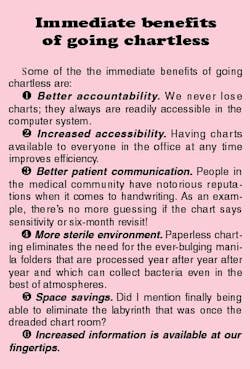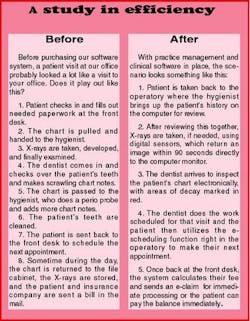software -- Profiting from the digital office
By Jeff Huling, DDS, and Janice Grange
Bill Gates, Larry Ellison, Dr. Jeff Huling. Jeff Huling? Yes, that's right! While I don't necessarily put myself in the same category as the leaders of Microsoft® and Oracle,® Mr. Gates and Mr. Ellison aren't the only people profiting from software. My office has been using our current practice-management software (EagleSoft from Patterson Dental) since 1996. We have profited in more ways than we can count, and your office can profit from it, too!
Since embarking on the road to a paperless office, life in my practice has become much more efficient. I am saving valuable time and money. In today's economy, when monolithic companies are spending millions of dollars to become more efficient, I view the cost of practice-management software and digital equipment — historically in the $25,000 range — as an investment that has put our office ahead of the game. We utilize EagleSoft, but there are other software companies out there — including Mogo and Easy Dental, among others — that dentists can use.
Six months ago, we made the decision to go paperless, or, more accurately, chartless. By going chartless, a computer now adorns every operatory and X-rays have gone completely digital. But the biggest change of all is that we've finally made the jump to computerized charting, eliminating paper charts from our daily operations.
By using clinical software, all chart notes are input electronically into our network, and can be viewed on any of the 19 monitors in our office. While I believe that there is no such thing as a truly paperless dental office, we've come a long way in eliminating redundancy, reducing human charting errors, and becoming more efficient in the process.
However, this doesn't happen overnight. It has taken six months to transfer clinical patient information into the system. No small feat, but worth the effort.
Practice management made easy
My staff is the first to admit that there is a learning curve to fully incorporating the benefits of a digital office. However, practice management truly is easy when the tools are at your fingertips. Every office will realize an immediate cost-saving benefit by using a computerized appointment book. (The appointment-book feature was offered in a package by EagleSoft as part of our initial purchase of the software, along with a searchable patient database and a financial program.)
As an example, the hygiene staff can efficiently book out six months in advance for many appointments. Because the scheduling feature allows the office to have a centralized appointment book that can be accessed from any of the operatories, future appointments can be scheduled and recorded before the patient ever leaves the chair. This eliminates the need for multiple scheduling callbacks or periodic mailings. I'll admit, it's a small cost on an individual patient basis. But, multiply those costs by your entire patient base and you'll soon realize the effect it can have on your bottom line.
The financial program captures amounts owed, determines insurance carriers, and sends e-claims. The searchable database comes in handy when figuring out the recall system when there are 7,500 patients to track. The financial program and electronic statements alone have saved the office staff hours of headaches and envelope-stuffing to get out statements. (Our mail carrier even hated our antiquated system. He wouldn't take all the statements we used to produce in-house because there were so many of them!) Now, we just send an electronic statement file to a fulfillment house and it does the stuffing and mailing for us. This has turned out to be much less expensive and more efficient. An added benefit? It frees up the staff's time to concentrate on other, more important tasks in the office ... like patient care!
Digitizing the X-ray process
Another area experiencing the streamlining effects of our software system and digitization integration is the X-ray process. In my mind, incorporating digital sensors into the office and being able to see an X-ray on a computer monitor in a few minutes sure beats film X-rays. We've eliminated X-ray developers, developing solutions, and film ... and the dark room has gone back to the Dark Ages. Of course, we no longer need to dry the X-rays and store them, because they are saved electronically on the server for future viewing. Occasionally, an insurance company wants a copy of an X-ray for its files and that duplication used to be a time-consuming energy drainer. Now the X-ray is simply printed on a piece of paper and either mailed or e-mailed to the requesting company. If we are keeping score in relation to steps needed, digitization clearly wins. Incorporation of the digital process is one step; elimination of costly, time-consuming, and antiquated processes is six steps!
Working in an office with 13 other people gives me a great deal of perspective on what efficiency can really mean to a business. I'm proud to say that my staff has completely streamlined our processes and everyone is on the same page. Change is typically hard. However, not one member of the staff would go back to the old, paper-filled system
At this point, some skeptics are thinking, "What happens if the server crashes?" Well, the information isn't lost; so don't lose any sleep over it. Our server has four hard drives, meaning if one crashes, there are three more to back it up. Plus, we perform a daily backup, which puts the information on a data tape as one final safeguard. That's more backup than you have when dealing with paper charts!
In addition to all the operating efficiencies, we now can communicate with patients more effectively and with a greater sense of immediacy than before. For example, we've had intraoral cameras for many, many years, but with the computerized practice-management system in place, we now can take a picture of the mouth, put the camera on a docking station hooked directly to the monitor in the operatory, and access that image in a couple of seconds to review with the patient. Our patients experience the value of better diagnostics because we can take an image the size of a marble on the camera and blow it up to the size of a basketball on the monitor in the operatory. In addition, we can even improve the contrast and quality of the image as we go from camera to screen.
The practice management and clinical software also allows us to flag everything we see as problem areas in the mouth, and they show up on the screen in red. Nine times out of 10, when we show patients the image of their mouths on the screen and what they see is in red, they have a tendency to want to get rid of it. (There is something about the color red that gets people's attention!) This application has increased our production simply because patients can see the problems clearly marked in their mouths and are motivated to accept treatment. It's all because the whole EagleSoft system — from hardware to software — is integrated throughout the office.
Digitization benefits for all
Patient communication and education are at an all-time high. With the ability to take a virtual tour of the mouth right in the operatory and store the images in the electronic chart, the hygienist and dentist are able to drive home the need to maintain proper oral health. When patients are looking right at a carious lesion, they get the point in a hurry that something needs to be done. Hygienists are more effective in educating patients because they can literally go over the history on-screen and show patients either progress or regression in seconds. Patient appointments are more efficient and diagnosis is more successful. A day at the office is much smoother now than before we computerized our practice-management systems.
On a personal note, EagleSoft has made a tremendous impact on my life and practice. At the end of the day, rather than having to review multiple charts, I have just a tiny stack of papers on my desk. With our software system in place and the continued digitization of the office, I'm getting out of the office 30 to 60 minutes earlier at the end of each day. Over the course of a year, that adds up to about 10 to 20 extra days that can be utilized in the office ... (or, in my case, spent with my family). That is time that is very important to me.
Bottom line: if I had to go back, I wouldn't! My staff members have taken to the software from the beginning with the passion that they put into everything they do. Practice-management and clinical software is more than just about workplace efficiency. It's about taking care of our patients as we do our own friends and family — the very best way that we possibly can!


